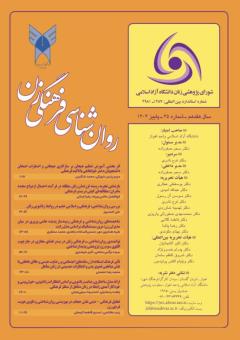توانمندی روانشناختی ـ فرهنگی زنان در بستر فضای مجازی در چارچوب الگوی سوم زن: پژوهشی پدیدارشناختی
محورهای موضوعی : روان شناسی
سیده نرگس صالحی
1
![]() ,
اکرم شوشتری
2
,
اکرم شوشتری
2
![]()
1 - استادیار، گروه آموزش روان شناسی و مشاوره، دانشگاه فرهنگیان، تهران، ایران
2 - استادیار، گروه آموزش علوم تربیتی، دانشگاه فرهنگیان، تهران، ایران
کلید واژه:
چکیده مقاله :
هدف پژوهش حاضر، تحلیل پدیدارشناختی توانمندی روانشناختی ـ فرهنگی زنان در بستر فضای مجازی در چارچوب الگوی سوم زن بود. جامعه آماری تمامی زنان ایرانی بود که بهطور فعال از فضای مجازی استفاده کرده و به نوعی در فرآیندهای علمی، اجتماعی، اقتصادی، فرهنگی و سیاسی در این فضا مشارکت داشتند. نمونه پژوهش،30 زن فعال در شبکههای اجتماعی بود که با روش هدفمند انتخاب شدند. روش پژوهش پدیدارشناختی وکیفی بود. دادهها از طریق مصاحبههای عمیق و نیمهساختاریافته با پرسشهای باز جمعآوری شد. مصاحبه ها با استفاده از روش تحلیل پدیدارشناختی کلایزی مورد بررسی قرار گرفت. سپس کدهای اولیه استخراج و در نهایت 5 مقوله اصلی و 16 مقوله فرعی شناسایی شدند. نتایج پژوهش نشان داد که فضای مجازی بستری را فراهم کرده است که زنان بتوانند به منابع معتبر علمی، آموزشی،دینی و دورههای آنلاین دسترسی داشته باشند و درک عمیقتری از جایگاه خود در جامعه اسلامی پیدا کنند.همچنین نتایج نشان داد که فضای مجازی در صورت استفاده آگاهانه، میتواند به ابزار مؤثری در جهت توانمندسازی روانی، فرهنگی،علمی، اجتماعی و اقتصادی زنان تبدیل شود. این فضا بستر مناسبی برای رشد ابعاد مختلف شخصیت زن، از جمله رشد معنوی، هویتی، علمی ،فرهنگی، اجتماعی و اقتصادی است. در واقع، با مدیریت صحیح و ارتقاء سواد رسانهای، میتوان از تهدیدهای فضای مجازی فرصت ساخت و زنان را در مسیر تحقق الگوی سوم زن که مبتنی بر تلفیق بین تعهد خانوادگی و حضور مؤثر اجتماعی است هدایت و حمایت کرد.
The purpose of this research was phenomenological analysis of the psychological-cultural empowerment of women in the virtual space context within the framework of the women third model. The statistical population of this research included Iranian women who actively used cyberspace and participated in some way in scientific, social, economic, cultural, and political processes in this space. The sample embraced 30 participants whom were selected via purposive sampling procedure. The research method was phenomenological and qualitative. Data were collected through in-depth and semi-structured interviews with open-ended questions. The interviews were examined using the Collizer phenomenological analysis method. Then, initial codes were extracted and finally 5 main categories and 16 subcategories were identified. The results of the study indicated that cyberspace had provided a platform for women to access reliable scientific, educational, and religious resources and online courses and gain a deeper understanding of their positions in Islamic society. The results also revealed that cyberspace, if used consciously, could become an effective tool for the psychological, cultural, scientific, social, and economic empowerment of women. Such space could be a suitable platform for the growth of various dimensions of a woman's personality, including spiritual, identity, scientific, cultural, social, and economic growth. In fact, with proper management and promotion of media literacy, threats in cyberspace would be turned into opportunities and women could be guided and supported on the path to realizing the third model of women, which is based on a combination of family commitment and effective social presence.


